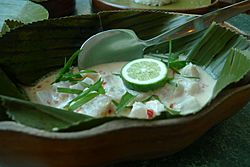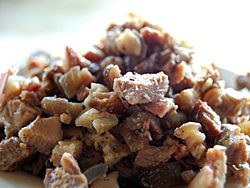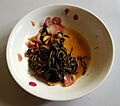Kinilaw facts for kids
 
Top: traditional fish kinilaw from Cagayan de Oro;
Bottom: kilawen kambing (goat meat kilawin) |
|
| Alternative names | Philippine ceviche, kilawin, lataven |
|---|---|
| Course | Appetizer |
| Place of origin | Philippines |
| Serving temperature | Room temperature, cold |
| Main ingredients | Seafood/meat/vegetables, vinegar, calamansi, onion, ginger, salt, siling labuyo, black pepper |
| Variations | Kilawen, kilayen, lawal, biyaring, kulao |
| Similar dishes | Paksiw, Philippine adobo, sisig |
Kinilaw (pronounced "kee-nee-lao") is a traditional Filipino dish. It means "eaten raw." It's mostly made with fresh, raw seafood. People sometimes call it "Philippine ceviche" because it's similar to the Latin American dish ceviche.
But kinilaw is more than just a dish. It's a way of preparing food. It uses vinegar and sour fruit juices, like citrus (from fruits such as lemons or limes), to "cook" the ingredients. These acids change the food, making it safe and tasty to eat without heat. Kinilaw is often eaten as a starter before a meal. It's also a popular snack (called pulutan) to enjoy with drinks.
Kilawin is a similar way of preparing food, but it uses meat. It's more common in the northern Luzon part of the Philippines. Unlike kinilaw, the meat in kilawin is usually lightly cooked, either by quickly boiling it (called blanching) or grilling it.
Contents
What is Kinilaw?
The most common kinilaw dish is kinilaw na isda, which means "fish kinilaw." It's made by cutting raw fish into small cubes. These fish cubes are then mixed with vinegar, often coconut vinegar or cane vinegar. The vinegar is the main ingredient that "cooks" the fish.
To make it even more delicious, souring agents are added. These can be fruits like calamansi, dayap, kamias, green mangoes, or tamarind. The dish is seasoned with salt and spices. Common spices include black pepper, ginger, onions, and chili peppers (like siling labuyo). A typical serving of fish kinilaw has about 147 calories.
To balance the taste and reduce any strong fishy smell, juices from grated tabon-tabon fruits, dungon fruits, or young coconuts are often added. Sometimes, extracts from the bark of sineguelas or bakawan trees (mangroves) are also used. Some versions of kinilaw also include coconut milk, sugar, or even soft drinks to make it less sour.
Seafood for Kinilaw
Many types of fish are used for kinilaw. These include tanigue (Spanish mackerel), malasugi (marlin or swordfish), tambakol, bangus, shark, and anchovies. Other seafood like shrimp, squid, clams, oysters, crabs, sea urchin roe, seaweed, jellyfish, and even shipworms (tamilok) can also be used.
It's very important that the seafood is super fresh and cleaned very well. This helps prevent any health problems from eating raw food. Some seafood, like squid, needs to be quickly boiled (blanched) first to make it soft.
Kinilaw with Fruits and Vegetables (Ensalada)
Kinilaw can also be made with raw fruits and vegetables. When it's made this way, it's sometimes called ensalada, which is the Spanish word for "salad."
Examples of these vegetable kinilaw dishes include pipino, ampalaya (bitter melon), young camote leaves, young papaya, pako (vegetable fern), and banana flowers.
Meat Kinilaw (Kilawin)
Most kilawin dishes come from the Luzon area. They use different kinds of meat, such as goat, beef, carabao (water buffalo), pork, and chicken.
Unlike fish kinilaw, meat kilawin is not eaten raw. The meat is cooked by boiling or grilling it, or sometimes both. It's usually cooked until it's rare to medium rare, but sometimes it's fully cooked. Meat kilawin is often eaten with papaít, which means "bittering agent." This is usually bile from an animal's gall bladder or juice from grass chewed by an animal. Just like with seafood, the meat for kilawin must be fresh and cleaned properly.
History of Kinilaw
Kinilaw is a very old dish from the Philippines. Archaeologists found evidence of kinilaw at a site called Balangay in Butuan. This site dates back to between the 10th and 13th centuries AD. They found pieces of tabon-tabon fruits and fish bones that looked like they had been cut for kinilaw. This shows that people have been making kinilaw for at least a thousand years!
Spanish explorers and colonists also wrote about kinilaw when they came to the Philippines. The first mention was in a dictionary from 1613 called Vocabulario de la lengua tagala. It was spelled cqinicqilao and cquilao. These spellings came from the Visayan word kilaw, which means "to eat raw." It's also related to the word hilaw, meaning "raw" or "uncooked."
Kinilaw is different from Latin American ceviches. Ceviche mainly uses citrus juices, which are not originally from the Americas. But kinilaw uses a mix of vinegar and citrus fruits, which are native to tropical Asia. It also uses other sour fruit juices.
Regional Types of Kinilaw
Some of the oldest kinilaw recipes are from the southern Visayas and Northern Mindanao. For example, Cagayan de Oro has its own kinilaw (sometimes called kinilaw de Oro), and Dumaguete has binakhaw. These are very old versions that use tabon-tabon and dungon fruits.
Many regions in the Philippines have their own special kinilaw dishes or names:
- In the Batanes islands in northern Philippines, the Ivatan people call kinilaw lataven. Their fish kinilaw is known as lataven a among.
- In Ilocos, the Ilocano kilawin kalding or kilawen is specifically grilled goat meat kinilaw.
- The Kapampangan people of Pampanga have quilain (or kilayen). Quilain babi is a kinilaw made with fully cooked pork, heart, liver, and tripe.
- In Cavite, the Tagalogs have a similar dish called kulao or kilawin na tainga ng baboy. This uses fully boiled pork ears. When mixed with fried tofu cubes, kulao becomes the well-known dish tokwa't baboy. Some modern versions of this dish also use soy sauce.
- In the southern Philippines, the Tausug people of the Sulu islands call fish kinilaw lawal. This version uses vinegar to wash the fish, and citrus fruits to "cook" it.
- Among the Sama-Bajau people, it's called kilau or kinilau. They sometimes add unripe mangoes to make it sour.
- The Maranao people of southwestern Mindanao make biyaring. This is a type of kinilaw made with tiny shrimp. It's special because it's often prepared while the shrimp are still alive!
A popular way to serve kinilaw in the Visayas and Mindanao islands is sinuglaw. This dish combines fish kinilaw (usually tuna) with charcoal-grilled pork belly (called sinugba).
Images for kids
-
Kinilaw na malasugi
(marlin) -
Kinilaw na malasugi
(marlin) -
Kinilaw na latô
(sea grapes) -
Kilawin na pusô ng saging
(banana flowers) -
Kinilaw nga galay sa camote
(camote leaves) -
Tokwa't baboy
(kilawin of pork & tofu) -
Ensaladang kangkong
(water spinach)
See also
 In Spanish: Kinilaw para niños
In Spanish: Kinilaw para niños









